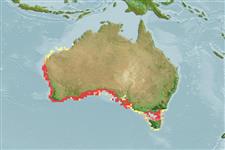Environment: milieu / climate zone / depth range / distribution range
ນິເວດວິທະຍາ
ສັດທະເລ; ນ້ຳກ່ອຍ ອາໄສຢູ່ໃກ້ໜ້າດິນໃຕ້ພື້ນທ້ອງນ້ຳ; ລະດັບຄວາມເລິກ 1 - 30 m (Ref. 9563). Subtropical; - 45°S
Eastern Indian Ocean: known only from southern Australia, from Western Australia to Victoria and Tasmania. Large adults have been misidentified as Platycephalus fuscus, the common estuarine flathead of New South Wales and southern Queensland (Ref. 9563).
Length at first maturity / ຂະໜາດ / ນ້ຳໜັກ / Age
Maturity: Lm 32.5 range ? - ? cm
Max length : 90.0 cm TL ຕົວຜູ້/ບໍ່ມີເພດ; (Ref. 9563)
ຄີ (ໜາມ)ແຂງຢູ່ຫຼັງປາ (ທັງໝົດ) : 8 - 9; ຄີຫຼັງຂອງປາ (ຄີອ່ອນ) (ທັງໝົດ) : 13 - 14; ຄີ(ໜາມ) ແຂງຢູ່ຄີກົ້ນປາ
ກຸ່ມປາກະດູກແຂງ
ຄວາມຖີ່ຂອງກຸ່ມຖ່າຍທອດພັນ
ປາທີ່ມີການເຄື່ອນຍ້າຍຈາກທະເລໄປຫານ້ຳຈືດ ແລະນ້ຳຈືດຫາທະເລ
ປາທີ່ມີການເຄື່ອນຍ້າຍຈາກທະເລແລະໄປໄຂ່ຢູ່ນ້ຳຈືດ
ຄີກົ້ນຂອງປາ
ສັດທີ່ມີກະດູກສັນຫັຼງ
ການຖ່າຍທອດທາງກຳມະພັນຈາກພໍ່ແມ່ຫາລູກ: 0; ຄີກົ້ນຂອງປາ: 13 - 14; ສັດທີ່ມີກະດູກສັນຫຼັງ: 27. Adults have 3-5 large round black spots with white margins on the lower-half of the caudal fin.
A shallow water species, recorded from surf beaches, estuaries and in bays (Ref. 9563).
Paxton, J.R., D.F. Hoese, G.R. Allen and J.E. Hanley, 1989. Pisces. Petromyzontidae to Carangidae. Zoological Catalogue of Australia, Vol. 7. Australian Government Publishing Service, Canberra, 665 p. (Ref. 7300)
IUCN Red List Status (Ref. 130435)
Threat to humans
Harmless
Human uses
ການປະມົງ: ທີ່ບໍ່ມີຄວາມສົນໃຈ
ເຄື່ອງມື
Special reports
Download XML
ແຫຼ່ງອີນເຕີເນັດ
Estimates based on models
Preferred temperature (Ref.
123201): 15.7 - 23.8, mean 18 °C (based on 215 cells).
Phylogenetic diversity index (Ref.
82804): PD
50 = 0.5000 [Uniqueness, from 0.5 = low to 2.0 = high].
Bayesian length-weight: a=0.00525 (0.00246 - 0.01120), b=3.04 (2.85 - 3.23), in cm total length, based on LWR estimates for this (Sub)family-body shape (Ref.
93245).
ຊັ້ນເຂດຮ້ອນ (Ref.
69278): 4.0 ±0.4 se; based on diet studies.
Generation time: 3.3 (2.5 - 4.4) years. Estimated as median ln(3)/K based on 11
growth studies.
ຄວາມຢືດຢຸ່ນ (Ref.
120179): ຂະໜາດກາງ, ປະຊາກອນຕຳ່ສຸດທີ່ໃຊ້ເວລາສອງເທົ່າ 1.4 - 4.4 ປີ (tm=1-2; tmax=12).
Fishing Vulnerability (Ref.
59153): Low to moderate vulnerability (35 of 100).
Nutrients (Ref.
124155): Calcium = 129 [10, 478] mg/100g; Iron = 1.84 [0.49, 4.79] mg/100g; Protein = 18.4 [16.1, 20.6] %; Omega3 = 0.299 [0.133, 0.836] g/100g; Selenium = 46.7 [12.9, 165.9] μg/100g; VitaminA = 7.74 [3.19, 18.47] μg/100g; Zinc = 0.841 [0.391, 1.706] mg/100g (wet weight);
